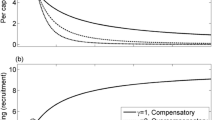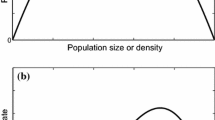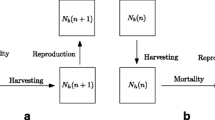Abstract
Understanding and predicting responses to increased mortality is important for conservation biology and population management strategies. In stage-structured populations, increased mortality of a particular stage can have the counterintuitive effect of causing increased abundance in one or more stages (called stage-specific overcompensation in density) or the whole population (called a hydra effect). We analyzed an n-stage, single-species, ordinary differential equation model in order to explore the mechanisms driving overcompensation in density and hydra effects in stage-structured populations. We find that in the absence of inter-stage competition, overcompensation in density only occurs if intra-stage competition in one stage is sufficiently strong to cause overcompensation in the maturation or reproductive rate of that stage (i.e., increased input causes decreased output for that stage). When there is inter-stage competition, overcompensation in density can also be driven by sufficiently strong inter-stage competition, even in the absence of overcompensation in any ecological rate. Hydra effects arise under the same conditions and are more likely to be caused by sufficiently strong intra-stage competition. We interpret our results in terms of the direct and indirect effects between stages, which helps clarify the relationships between stage-specific overcompensation in density, overcompensation in ecological rates and hydra effects.




Similar content being viewed by others
References
Abrams PA (2009) When does greater mortality increase population size? The long history and diverse mechanisms underlying the hydra effect. Ecology Letters 12:462–474
Abrams PA (2019) How does the evolution of universal ecological traits affect population size? Lessons from simple models. The American Naturalist 193(6):814–829
Abrams PA, Matsuda H (2005) The effect of adaptive change in prey on the dynamics of an exploited predator population. Canadian Journal of Fisheries and Aquatic Sciences 62:758–766
Abrams PA, Vos M (2003) Adaptation, density dependence and the responses of trophic level abundances to mortality. Evolutionary Ecology Research 5:1113–1132
Abrams PA, Brassil CE, Holt RD (2003) Dynamics and responses to mortality rates of competing predators undergoing predator-prey cycles. Theoretical Population Biology 64:163–176
Bender EA, Case TJ, Gilpin ME (1984) Perturbation experiments in community ecology: theory and practice. Ecology 65:1–13
Buckley YM, Hinz HL, Matthies D, Rees M (2001) Interactions between density-dependent processes, population dynamics and control of an invasive plant species, Tripleurospermum perforatum (scentless chamomile). Ecology Letters 4(6):551–558
Cameron T, Benton T (2004) Stage-structured harvesting and its effects: an empirical investigation using soil mites. Journal of Animal Ecology 73(5):996–1006
Cortez MH (2016) Hydra effects in discrete-time models of stable communities. Journal of Theoretical Biology 411:59–67
Cortez MH, Abrams PA (2016) Hydra effects in stable communities and their implications for system dynamics. Ecology 97(5):1135–1145
Cortez MH, Yamamichi M (2019) How (co)evolution alters predator responses to increased mortality: extinction thresholds and hydra effects. Ecology 100(10):e02789
de Roos AM (2018) When individual life history matters: conditions for juvenile-adult stage structure effects on population dynamics. Theoretical Ecology 11(4):397–416
De Roos AM, Persson L (2002) Size-dependent life-history traits promote catastrophic collapses of top predators. Proceedings of the National Academy of Sciences 99(20):12907–12912
de Roos AM, Persson L (2013) Population and community ecology of ontogenetic development. Princeton University Press, New Jersey
de Roos AM, Schellekens T, van Kooten T, van de Wolfshaar K, Claessen D, Persson L (2007) Food-dependent growth leads to overcompensation in stage-specific biomass when mortality increases: the influence of maturation versus reproduction regulation. The American Naturalist 170(3):E59–E76
Karatayev V, Kraft C, Zipkin E (2015) Racing through life: maturation rate plasticity regulates overcompensation and increases persistence. Ecosphere 6(10):1–12
Meyer KA, Lamansky JA Jr, Schill DJ (2006) Evaluation of an unsuccessful brook trout electrofishing removal project in a small Rocky Mountain stream. North American Journal of Fisheries Management 26(4):849–860
Nicholson AJ (1957) The self-adjustment of populations to change. Cold Spring Harbor Symposia on Quantitative Biology, Cold Spring Harbor Laboratory Press 22:153–173
Novak M, Wootton JT, Doak DF, Emmerson M, Estes JA, Tinker MT (2011) Predicting community responses to perturbations in the face of imperfect knowledge and network complexity. Ecology 92:836–846
Pardini EA, Drake JM, Chase JM, Knight TM (2009) Complex population dynamics and control of the invasive biennial Alliaria petiolata (garlic mustard). Ecological Applications 19(2):387–397
Persson L, de Roos AM (2013) Symmetry breaking in ecological systems through different energy efficiencies of juveniles and adults. Ecology 94(7):1487–1498
Persson L, Amundsen PA, de Roos AM, Klemetsen A, Knudsen R, Primicerio R (2007) Culling prey promotes predator recovery alternative states in a whole-lake experiment. Science 316(5832):1743–1746
Reznick D, Butler MJ IV, Rodd H (2001) Life-history evolution in guppies VII. The comparative ecology of high-and low-predation environments. The American Naturalist 157(2):126–140
de Roos A, Persson L, Thieme HR (2003) Emergent allee effects in top predators feeding on structured prey populations. Proceedings of the Royal Society of London Series B: Biological Sciences 270(1515):611–618
Schreiber S, Rudolf VH (2008) Crossing habitat boundaries: coupling dynamics of ecosystems through complex life cycles. Ecology Letters 11(6):576–587
Schröder A, van Leeuwen A, Cameron TC (2014) When less is more: positive population-level effects of mortality. Trends in Ecology and Evolution 29:614–624
Sieber M, Hilker FM (2012) The hydra effect in predator-prey models. Journal of Mathematical Biology 64:341–360
Slobodkin LB, Richman S (1956) The effect of removal of fixed percentages of the newborn on size and variability in populations of Daphnia pulicaria (forbes). Limnology and Oceanography 1(3):209–237
Smallegange IM, Fernandes RE, Croll JC (2018) Population consequences of individual heterogeneity in life histories: overcompensation in response to harvesting of alternative reproductive tactics. Oikos 127(5):738–749
Smith PA, Leah RT, Eaton JW (1996) Removal of pikeperch (Stizostedion lucioperca) from a british canal as a management technique to reduce impact on prey fish populations. In: Annales Zoologici Fennici, JSTOR 537–545
Watt KE (1955) Studies on population productivity: I. Three approaches to the optimum yield problem in populations of Tribolium confusum. Ecological Monographs 269–290
Weidel BC, Josephson DC, Kraft CE (2007) Littoral fish community response to smallmouth bass removal from an Adirondack lake. Transactions of the American Fisheries Society 136(3):778–789
Yodzis P (1988) The indeterminacy of ecological interactions as perceived through perturbation experiments. Ecology 69:508–515
Zipkin EF, Sullivan PJ, Cooch EG, Kraft CE, Shuter BJ, Weidel BC (2008) Overcompensatory response of a smallmouth bass (Micropterus dolomieu) population to harvest: release from competition? Canadian Journal of Fisheries and Aquatic Sciences 65:2279–2292
Acknowledgements
MHC thanks Florida State University for support.
Funding
MHC was supported by funds provided by Florida State University.
Author information
Authors and Affiliations
Contributions
DKS and MHC contributed to all aspects of the study with DKS being the lead on all analyses and writing.
Corresponding author
Ethics declarations
Conflicts of interest
The authors declare that they have no conflicts of interest.
Ethics approval
Not applicable
Consent to participate
Not applicable
Consent for publication
All authors have read the study and consented to submission.
Availability of data and material
No new data generated in this study.
Code availability
All Maple and MATLAB codes are available by request from the authors.
Additional information
Short title: numerical density and hydra effects 0 tables; 3 color figures; Online Appendices S1-S4.
Electronic supplementary material
Below is the link to the electronic supplementary material.
Rights and permissions
About this article
Cite this article
Sorenson , D.K., Cortez, M.H. How intra-stage and inter-stage competition affect overcompensation in density and hydra effects in single-species, stage-structured models. Theor Ecol 14, 23–39 (2021). https://doi.org/10.1007/s12080-020-00488-1
Received:
Accepted:
Published:
Issue Date:
DOI: https://doi.org/10.1007/s12080-020-00488-1




